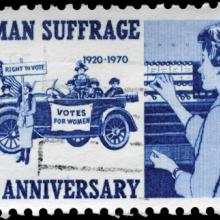Women
Leaders of the Seventh-day Adventist Church on Tuesday said recent decisions by two regional bodies to allow ordained female pastors were "serious mistakes," and women who are ordained won't be recognized — at least for now.
“They directly challenge two world Church decisions on the matter of ordination,” reads a statement, passed by a 264-25 vote during the Annual Council meeting in Silver Spring, Md. “They create doubts about the importance of collective decision-making as a basic feature of denominational life.”
The decisions by the Maryland-based Columbia Union Conference and the California-based Pacific Union Conference came as the worldwide church is in the midst of a broad study of the “theology of ordination” that is expected to be considered at the denomination’s 2015 General Conference Session.
It's Thursday. I'm hitting the back of my closet and have second-day hair. Relate? Good, then this video is for you.
Take a few minutes to remember that our differences — whether it be crooked smiles, frizzy hair, or 6-foot-frame — to others look like character, enviable natural curls, or modelesque stature. You're beautiful. (Yes, you.)
The clip is also full of good advice, but my personal favorite: "If it makes you feel awesome, wear it." (Do you think that means I can get away with yoga pants at work?)
SALT LAKE CITY — Call it a change for the ages.
In a surprising move that promises to transform Mormon social and spiritual dynamics, the Church of Jesus Christ of Latter-day Saints on Oct. 6 announced that it is lowering the age of full-time missionary service to age 18 for men (down from 19) and 19 for women (down from 21).
“The Lord is hastening this work,” LDS apostle Jeffrey R. Holland said at a news conference, “and he needs more and more willing missionaries.”
The church is counting on this change to dramatically increase the ranks of its full-time missionaries, currently more than 58,000 worldwide.
Since the establishment of The Council for Biblical Manhood and Womanhood in 1987 and J.I. Packer’s 1991 article “Let’s Stop Making Women Presbyters” in Christianity Today, there’s been a resurgence of traditionalist theology among some American churches. Instead of advocating “male headship,” they now promote “complementarianism.” Instead of portraying women as intrinsically “serving, subordinate, and supportive,” they now advocate “biblical womanhood.” But it’s the same patriarchal heresy, just with new language.
Rachel Held Evans, a Tennessee-based evangelical Christian raised in conservative Christian churches, decided to turn the tables. She vowed to take all of the Bible’s instructions for women as literally as possible for a year. A Year of Biblical Womanhood: How a Liberated Woman Found Herself Sitting on Her Roof, Covering Her Head, and Calling Her Husband Master is the often-hilarious, engaging, well-researched, deadly serious result. (You can read all about her adventures at rachelheldevans.com). Former Sojourners editorial assistant Betsy Shirley, a student at Yale Divinity School, interviewed Evans in August 2012.
Across Sacred Fences
More than 50 contributors offer moving, insightful personal essays about interfaith experiences in My Neighbor’s Faith: Stories of Interreligious Encounter, Growth, and Transformation. Edited by Jennifer Howe Peace, Or N. Rose, and Gregory Mobley. Orbis Books
Women Rising
On Oct. 1 and 2, PBS will air the two-part special Half the Sky. Inspired by Nicholas Kristof and Sheryl WuDunn’s best-selling book of the same name, the film follows the authors through 10 countries to meet people challenging extreme gender inequality and the poverty, trafficking, and violence it perpetuates. pbs.org/independentlens
EVER SINCE THE apostles positioned Mary Magdalene as an “unreliable narrator” telling an “idle tale” in Jesus’ resurrection story, some men in the church have claimed maleness as normative and orthodox and femaleness as, well, not.
In the recent case of the Vatican vs. the Leadership Conference of Women Religious (LCWR), the integrity of women’s witness is, once again, called into question by male hierarchs.
These Catholic sisters represent an unbroken, cohesive expression of faith in the history of American Catholicism and in women’s presumption of equality, completeness, and active moral agency both under law and under God—a presumption that is a shining light for women around the world. The sisters might have once shared accolades for faithful servant leadership with their brother priests, bishops, and cardinals, but over the course of nearly 30 years of unfolding pedophilia scandal and blasphemous mob-like cover-up, the laity has learned to look to the sisters alone for examples of Catholic gospel witness and Christian maturity, strength, and just plain grit.
But let’s not sideline this issue as “a Catholic thing.” We don’t get off that easy. The struggle over women’s authority runs right through the denominational diaspora of the body of Christ.
In what is being described as the first of its kind in the U.S., the Archdiocese of New Orleans has transformed a vacant church rectory into a group house where single women will live together while deciding whether to undertake lives as nuns.
The center, dedicated on Aug. 15, occupies the second and third floors of the St. Rita rectory. Within a few days, two women, then perhaps three more, will move into the spotless rectory, their collective lives to be superintended by two veteran nuns who will show the younger women the dynamics of shared community life.
“How we live in community. How to communicate. How to share,” said Sister Carmen Bertrand, for 48 years a member of the Sisters of the Holy Family.
Beyond orienting them to the rhythms of community life, Bertrand and her colleague, Sister Diane Roche, a Religious of the Sacred Heart, will teach the tenants various modes of prayer, organize occasional retreats, and bring in representatives of other religious orders to present themselves and their ways of life.
AFRICAN-AMERICAN women’s wisdom emerges from an experience of triple (or more) oppression. Denied the dignity of womanhood, condemned for their skin color, whether too dark or too light, and often imprisoned by mis-education, demeaning and meaningless work, and a denial of their very humanity, African-American women have yet managed to forge a spirituality of hope and survival that has sustained them for centuries.
As Alice Walker noted, they dreamed dreams and had visions; they imagined a time and place when the pain and indignity of their lives would be transcended, not in some far-off heaven but right here in the future of their children and their children’s children. Somehow our foremothers persisted in their faith. They made rosaries out of beads and knotted string and learned scripture by rote memory. They resisted as best they could anything and anyone who attempted to keep them from living their faith on a daily basis.
Once freedom, so-called, came, they struggled, despite the callous disregard of their fellow Christians, to remain faithful. When their children were forbidden entry into diocesan or public schools, when they were required to sit in upper galleries and back pews, when they had to wait until last to partake of the sacraments, they did not suffer these indignities quietly but often walked out and with their meager resources built their own schools and church buildings.
Big Olympic news today from Reutuers:
China has vehemently rejected suggestions of doping as a growing row over the astonishing performance of a Chinese swimmer threatens to overshadow Michael Phelps’s bid to become the most decorated Olympian of all time on Tuesday.
For those of you who don’t speak in sports lingo or Britishisms, that translates to “Chinese coaches reject claims that their star swimmer, Ye Shiwen, has been taking illegal, performance-enhancing drugs.”
Here’s the context. Yesterday, Ye Shiwen, a 16-year-old Chinese woman swam the 400 meter medley faster than all-star swimmer Ryan Lochte, a man from the U.S.A.
WHAT??!! Throw up the red flag! Women can’t be better than men at sports! Call in the drug dogs and blood tests. (The Twitterverse and other social media quickly echoed similar sentiments, rolling their collective eyes at outrage that a woman could break a man's speed.)
According to the report, Ye Shiwen went through "extremely thorough" tests from the World Anti-Doping Agency, and the British Chairman of the Olympic Association said she’s clean.
"That's the end of the story. Ye Shiwen deserves recognition for her talent."
I have a love/hate relationship with the Olympics. I love the pageantry and global drama of it all. And even as one who hardly ever watches sports (I make exceptions for Roller Derby and Quidditch), I nevertheless find myself glued to the screen whenever the Olympics roll around. At the same time I am uneasy with the neo-colonial aspects of the Games and the fact that one’s ability to win a medal increasingly depends upon how much money one’s country has (making the Games a vivid illustration of global economic injustice). Yet even as I have watched (and enjoyed) the London Games with conflicted emotions, I find myself more and more uncomfortable with the ways the presentation of the Olympics serves to reinforce harmful assumptions about women in our culture.
It started before the Games. As the world geared up for the Olympics, it was hard to avoid hearing some guy or another (from TV hosts to bloggers) saying that what they were most looking forward to watching was women’s beach volleyball. It was this strange inside joke insinuating that the real purpose of the Games was to give them an opportunity to see women diving around in bikinis. I even heard complaints about the new Olympic rule allowing women to compete fully covered (a concession offered to allow Muslim women to compete in the Games). It was uncomfortable to hear how nonchalantly women continue to be reduced to mere sexual objects, but I brushed it aside as typical of our culture.
Writing for The Nation, Bryce Covert examines how state-level opt outs of Medicaid expansions will affect women:
"The Medicaid expansion is a crucial component of the law’s overall goal of extending coverage to over 30 million uninsured Americans by 2019, covering almost half of the total number of people the bill promised to insure. Originally, the law included a provision that the federal government could take away all of a state’s Medicaid funding if it refused to go along with the expansion, which all but ensured participation. But the Court ruled that such a maneuver was unconstitutional. Just a few days after the decision was announced, seven Republican governors said they would flat-out reject the money to expand Medicaid rolls, with at least eight more looking to follow suit. More have said no since then.
This could create a no-man’s land for those who earn less than 100 percent of the federal poverty line, making them ineligible for tax subsidies to help them buy insurance, but don’t qualify for their state’s (unexpanded) Medicaid program. These Americans are surely struggling to get by, but not quite enough to get health coverage promised to those above and below them."
Read more here
EDITOR'S NOTE: Melinda Gates talks to the Guardian (UK) newspaper about reconciling her Catholic faith — the wife of Microsoft chairman Bill Gates says she attends mass regularly — with her work promoting family planning. Gates was in London this week to discuss promoting contraception in the developing world with UK government representatives. The Gates Foundation hopes to encourage donor pledges that will enable 120 million women to have access to contraceptives by 2020.
WHENEVER I entered a museum gallery and saw sculptures by Elizabeth Catlett, I wanted to touch them. The figures were often smooth, glistening, and engaging. They spoke to me in the same manner as the poetry of Langston Hughes and the musical compositions of Duke Ellington.
When Catlett died in April, I was reminded again that she created artwork for celebration and spiritual nourishment. She mastered the ability to bring beauty out of wood and stone.
In many ways Catlett was ahead of her times. During the 1940s she had explored the black woman’s body as a theme for sculpture and paintings. The images she created upheld the strength and dignity of women. The black woman presented as mother could be seen nurturing a child. In work such as “Homage to My Young Black Sisters,” the black woman figure strikes a posture of resistance with a fist raised. The buttocks of the cedar sculpture reflect strength as well as sensuality. One is quickly reminded of young Student Nonviolent Coordinating Committee workers, members of the Black Panther Party, and even activist Angela Davis. “Homage to My Young Black Sisters” was created in 1968, the same year the Summer Olympics in Mexico City saw track stars John Carlos and Tommie Smith raise their fists on the awards stand in a black power salute.
The art of Elizabeth Catlett ignored borders. Although she resided in Mexico, her work reflected the changing consciousness of African Americans in the 1960s and 1970s. The civil rights and black power movements renewed interest in African-American history. The black art movement introduced a desire to define a black aesthetic. Catlett’s work as an elder provided younger artists with a model and a teacher to emulate. In 1969, she created the print “Malcolm X Speaks for Us.” In it we see how she links Malcolm’s face to that of other black faces. The result is a powerful sense of community.
Five of my female Facebook friends had posted the article in a span of about two hours. The headline, “Why Women Still Can’t Have It All,” stared at me, daring me to respond.
Read it, first. Then come back here. Go ahead, take the half-hour (it’s a long one). Read the WHOLE thing.
Back?
OK, so there are some good points in there, right? If you want to be a political power player in Washington, D.C., forcing you to live long-distance from your husband and children, maaaaybe you’re not going to be the happiest person ever. Maybe you can’t “have it all.”
But why is that the question to begin with? Why does this topic of conversation perennially rear it’s head to make women feel like they’re not doing it right? And why is the question never asked of men?
So the ‘thinner-and-sexier evolution” series is kind of winding down, as there are (thankfully, I think?) only a limited number of consumer products that have been around long enough so as to be able to undergo some kind of thin-and-sexy transformation. Besides, at this point, it’s kind of "clicked there, browsed that," you know? Especially since every toy/image transformation does some basic variation on the theme of “thin down and sex up.”
Call it the Barbiefication of toys for girls.
Or, you could call it what the American Psychological Association does, which is sexualization. Sexualization, as opposed to healthy sexuality, is defined (by the APA) as any one of the following:
- a person’s value comes only from his or her sexual appeal or behavior, to the exclusion of other characteristics;
- a person is held to a standard that equates physical attractiveness (narrowly defined) with being sexy;
- a person is sexually objectified — that is, made into a thing for others’ sexual use, rather than seen as a person with the capacity for independent action and decision making; and/or
- sexuality is inappropriately imposed upon a person.
No, I didn’t hit my head. I’m not suffering from amnesia. I’m just really confused.
I’m sorry — what year is it again? Running through my handy list o’ headlines, it’s a little bit difficult to tell.
I give you the 10 reasons I don’t believe that it’s really 2012.
Yesterday, the Paycheck Fairness Act came before the senate, seeking to close the wage gap between men and women. And as expected, the bill failed to pass, resulting in only 52 supporters, short of the 60 needed. All Republicans voted against the measure and none discussed it on the Senate floor before yesterday’s vote.
“In 1963 we made 59 cents for every dollar that men made. Now it’s 77 cents,” says Barbara Mikulski of Maryland, chief sponsor of the proposed bill. “What does that mean? It means every five years we make an advancement of one penny. Oh no. No more. We’re not just going to take it anymore.”
See more in The Washington Post
A long-simmering conflict between the Vatican and American nuns erupted again on June 4 when the Vatican's doctrinal office issued a scathing critique of a popular book on sexual ethics by Sister Margaret A. Farley, one of the first Catholics to teach at Yale Divinity School.
After two years of study, the Vatican's Congregation for the Doctrine of the Faith published a “notification” on Farley's “Just Love: A Framework for Christian Sexual Ethics,” saying it contradicts Catholic doctrine on key issues such as gay marriage, homosexuality and divorce.
Coming just days after U.S. nuns rejected the Vatican's reasoning for a wholesale makeover, and a year after U.S. bishops sanctioned another nun theologian, the condemnation of Farley is the latest example of what critics see as a top-down attempt to muzzle women's voices and an obsession on sexual ethics.
This anniversary may have passed you by, but on this day in 1919, The US Senate passed the 19th Amendment. Almost seventeen months after being introduced by the House of Representatives, women were given the right to vote.
It reads:
The right of citizens of the United States to vote shall not be denied or abridged by the United States or by any State on account of sex. Congress shall have power to enforce this article by appropriate legislation.
And after the 15th and19th amendment passed, voting rights are signed, sealed, delivered, right?









